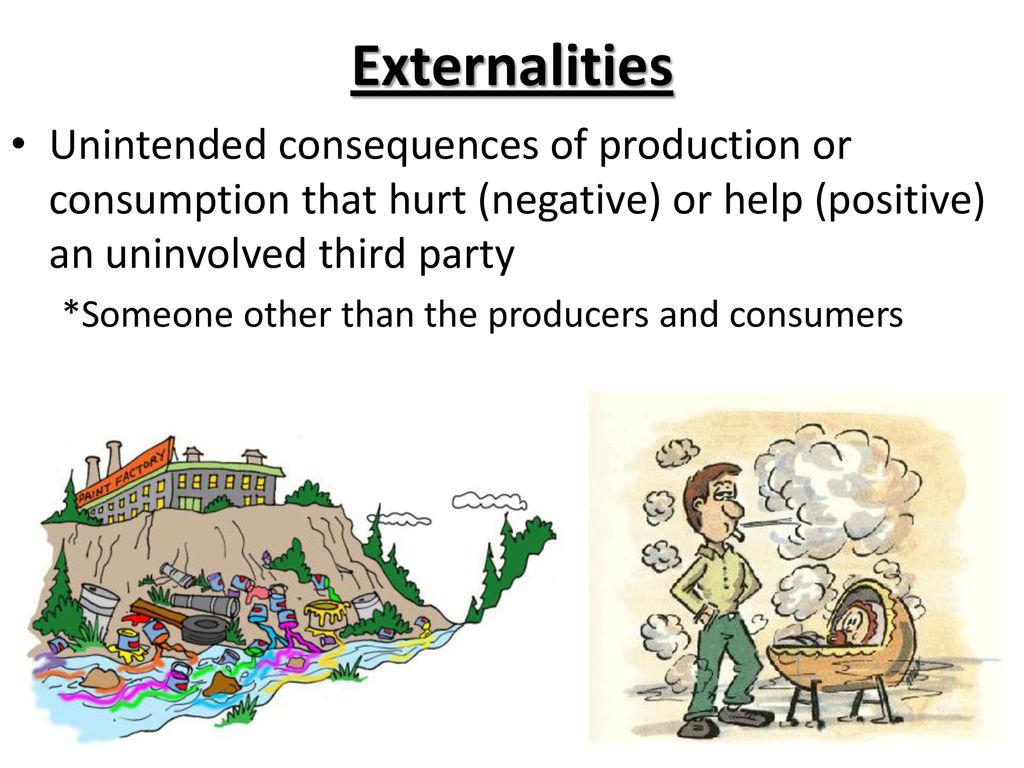
Externalities: The Unintended Consequences of Economic Activity
Life is full of side effects. You buy a new car, and while you enjoy the ride, the exhaust fumes contribute to air pollution. Your neighbor plants a beautiful garden, and while they enjoy the flowers, you also get to enjoy the pleasant view from your window. In economics, these "side effects" – the benefits or costs that affect a third party not directly involved in a transaction – are known as externalities.
Externalities are a fascinating and crucial concept because they highlight how economic decisions, seemingly private, can have ripple effects throughout society. They often lead to situations where markets don’t operate as efficiently as they could, creating what economists call "market failure."
This comprehensive guide will break down externalities in an easy-to-understand way, exploring their different types, why they occur, real-world examples, and the various ways societies try to manage them.
What Exactly Are Externalities? The Basic Idea
Imagine you’re buying a cup of coffee. The transaction is between you and the coffee shop. You get your coffee, they get your money. Simple, right?
But what if the coffee shop uses a noisy generator that disturbs the residents nearby? Or what if, by selling that coffee, they’re also supporting sustainable farming practices that benefit the environment far away? These are the externalities.
An externality occurs when an economic activity (like production or consumption) creates a cost or benefit for a third party who is not directly involved in the activity.
Here’s the key:
- Third Party: Someone or something (like the environment) who isn’t the buyer or seller.
- Not Directly Involved: They didn’t agree to incur the cost or receive the benefit.
- Unintended Consequence: The primary goal of the economic activity wasn’t to create this specific cost or benefit for the third party.
Externalities are important because they mean the private cost (what the producer pays) or private benefit (what the consumer gets) of an activity doesn’t always match the social cost (the true cost to society) or social benefit (the true benefit to society). When there’s a mismatch, it often leads to inefficient outcomes.
Two Main Flavors: Negative vs. Positive Externalities
Externalities can be broadly categorized into two types: those that impose a cost and those that provide a benefit.
1. Negative Externalities: The Unwanted Side Effects
A negative externality occurs when an economic activity imposes a cost on a third party. Think of these as the "bad" side effects.
- Definition: When the production or consumption of a good or service harms a third party not involved in the transaction.
- Key Characteristic: The social cost is greater than the private cost. The people making or consuming the product don’t bear the full cost of their actions.
Common Examples of Negative Externalities:
- Pollution from a Factory: A steel mill produces steel (a good) but also releases smoke and wastewater into the air and rivers. This pollution harms the environment, local residents’ health, and wildlife. The factory’s private cost doesn’t include the cost of cleaning up the pollution or treating sick residents.
- Noise Pollution: A loud concert or construction site might disturb nearby residents, reducing their quality of life. The concert organizers or construction company don’t compensate the residents for this disturbance.
- Traffic Congestion: When more people drive cars, it leads to traffic jams, increasing travel time and fuel consumption for everyone on the road, even those who weren’t the initial cause of the congestion.
- Second-Hand Smoke: A person smoking in public might enjoy their cigarette, but others nearby inhale the smoke, risking their health without choosing to.
- Overfishing: When one fishing company overfishes, it depletes fish stocks for other companies and future generations, harming the shared resource.
Why are they a problem? Because the producers or consumers don’t pay the full cost, they tend to engage in too much of the activity from society’s perspective. The market produces more pollution, more noise, more traffic than is socially optimal.
2. Positive Externalities: The Welcome Bonuses
A positive externality occurs when an economic activity provides a benefit to a third party. Think of these as the "good" side effects.
- Definition: When the production or consumption of a good or service benefits a third party not involved in the transaction.
- Key Characteristic: The social benefit is greater than the private benefit. The people making or consuming the product don’t receive all the benefits of their actions.
Common Examples of Positive Externalities:
- Education: When individuals get educated, they not only benefit personally (better jobs, higher income) but also contribute to a more informed, productive, and innovative society, which benefits everyone. A more educated populace might lead to lower crime rates or more civic engagement.
- Vaccinations: When someone gets vaccinated, they protect themselves, but they also reduce the spread of disease to others (herd immunity), benefiting the entire community, especially those who cannot be vaccinated.
- Research & Development (R&D): A company investing in R&D might discover a new technology (e.g., the internet, GPS). While they profit, the knowledge and innovation often spill over, benefiting countless other industries and individuals who didn’t pay for the initial research.
- Beekeeping: A beekeeper produces honey (their private benefit), but their bees also pollinate nearby crops and flowers, benefiting farmers and the ecosystem without direct payment.
- Restored Historic Buildings: An owner restoring a historic building improves its value and provides a beautiful aesthetic for the entire neighborhood, attracting tourism and boosting local pride.
Why are they a problem? Because the producers or consumers don’t receive all the benefits, they tend to engage in too little of the activity from society’s perspective. The market produces less education, fewer vaccinations, and less R&D than is socially optimal.
Why Do Externalities Occur? The Problem of "Market Failure"
Externalities are a prime example of market failure. In a perfectly efficient market, the "invisible hand" (Adam Smith’s concept) guides resources to their most productive uses, and the price of a good reflects all its costs and benefits. However, when externalities exist, this doesn’t happen.
Here’s why:
- Missing Prices: Externalities often arise because there isn’t a market price for the "side effect" itself. There’s no price for clean air or the benefit of herd immunity. Without a price, these costs or benefits aren’t factored into the decisions of buyers and sellers.
- Property Rights Issues: Sometimes, it’s unclear who "owns" a resource like clean air or a quiet neighborhood. If no one "owns" it, no one can charge for its use (or its degradation).
- Information Asymmetry: Buyers and sellers might not have full information about the long-term or widespread consequences of their actions.
- Self-Interest vs. Social Interest: Individuals and firms naturally act in their own self-interest to maximize their private benefits or minimize their private costs. They don’t automatically consider the wider social impact unless there’s an incentive or regulation to do so.
The result of market failure due to externalities is inefficiency:
- With negative externalities: The market produces too much of the good or service because the full social cost isn’t being paid.
- With positive externalities: The market produces too little of the good or service because the full social benefit isn’t being captured.
This means society isn’t achieving its maximum potential well-being; resources are misallocated.
Addressing Externalities: Solutions and Strategies
Since externalities lead to inefficient outcomes, economists and policymakers have devised various strategies to "internalize" them – that is, to make the costs and benefits visible and accounted for in the decisions of producers and consumers.
Solutions generally fall into two categories: government intervention and private solutions.
A. Government Intervention
Governments often step in to correct market failures caused by externalities because they have the power to enact laws, levy taxes, and provide subsidies.
-
Taxes (Pigouvian Taxes for Negative Externalities):
- How it works: The government imposes a tax on activities that generate negative externalities. This tax increases the private cost of the activity, making it more expensive and thus discouraging it.
- Example: A carbon tax on industries that emit greenhouse gases. This makes polluting more expensive, incentivizing companies to reduce emissions or find cleaner alternatives.
- Goal: To make the private cost equal to the social cost.
-
Subsidies (for Positive Externalities):
- How it works: The government provides financial assistance (subsidies) for activities that generate positive externalities. This lowers the private cost or increases the private benefit, encouraging more of the activity.
- Example: Subsidies for education (e.g., grants, public schools), vaccinations, or research and development.
- Goal: To make the private benefit equal to the social benefit.
-
Regulation (Command-and-Control):
- How it works: The government directly dictates specific behaviors, often through laws, rules, or limits.
- Examples:
- Bans: Banning certain harmful chemicals (like DDT).
- Quotas: Limiting the amount of pollution a factory can emit.
- Standards: Requiring cars to meet certain emission standards.
- Mandates: Requiring vaccinations for school entry.
- Pros: Can be effective and provide certainty.
- Cons: Can be less flexible and sometimes less cost-effective than market-based solutions, as they don’t always incentivize the cheapest way to reduce pollution or provide a benefit.
-
Creating Markets (e.g., Cap-and-Trade):
- How it works: The government sets a total limit (cap) on a negative externality (like pollution). Then, it issues permits to pollute up to that limit, and these permits can be bought and sold (traded) in a market.
- Example: Emissions trading schemes. Companies that can reduce pollution cheaply sell their excess permits, while those for whom it’s expensive buy permits. This incentivizes the most cost-effective reductions.
- Pros: Market-based, flexible, encourages innovation.
- Cons: Can be complex to set up and monitor.
B. Private Solutions
Sometimes, externalities can be resolved without direct government intervention, especially when the number of parties involved is small and property rights are clearly defined.
-
Coase Theorem (Bargaining and Property Rights):
- How it works: Developed by economist Ronald Coase, this theorem suggests that if property rights are well-defined and transaction costs (the costs of negotiating and enforcing an agreement) are low, private parties can bargain among themselves to reach an efficient solution to externalities, regardless of who initially holds the property rights.
- Example: If a noisy factory is next to a quiet neighborhood, and property rights to "quiet enjoyment" are clear, the residents could pay the factory to reduce noise, or the factory could pay the residents for the right to make noise. An agreement would be reached that makes both parties better off (or at least no worse off) than the current situation.
- Limitation: This works best with a small number of parties. Imagine trying to negotiate with millions of car drivers about traffic congestion!
-
Social Norms, Moral Codes, and Charities:
- How it works: Society’s values, cultural norms, and individual altruism can influence behavior to reduce negative externalities or promote positive ones.
- Examples:
- Recycling: Many people recycle not because of a direct financial incentive but because it’s seen as the "right thing to do."
- Volunteering: People volunteer their time or donate to charities that fund education, environmental protection, or disease research.
- Etiquette: Keeping noise down in public places.
-
Integration of Businesses:
- How it works: If two businesses that create an externality for each other merge, the externality becomes "internal" to the new, larger company.
- Example: A bee farmer and an apple orchard merge. The pollination externality from the bees to the apple trees is now an internal benefit for the combined company.
The Challenge of Externalities
While the solutions seem straightforward in theory, implementing them in the real world is often complex:
- Measurement Difficulty: It’s hard to accurately measure the exact cost of pollution or the full benefit of education.
- Political Will: Implementing taxes or regulations can be unpopular and face political resistance from affected industries or individuals.
- Distributional Effects: Solutions can impact different groups disproportionately. A carbon tax might disproportionately affect lower-income households if not designed carefully.
- Global Nature: Some externalities, like climate change, are global, requiring international cooperation, which is notoriously difficult.
Conclusion: Understanding the Unseen Impact
Externalities are a fundamental concept in economics that reminds us that few actions exist in isolation. Every decision we make, every product we consume, every service we provide, can have ripple effects that extend far beyond the immediate transaction.
By understanding externalities – both the harmful negative ones and the beneficial positive ones – we can better grasp why markets sometimes fail to deliver optimal outcomes. More importantly, this understanding empowers us to advocate for and implement policies that help internalize these unintended consequences, guiding economic activity towards a more efficient, equitable, and sustainable future for everyone. It’s about ensuring that the true costs and benefits of our actions are reflected, leading to a better balance between private gain and public good.




Post Comment